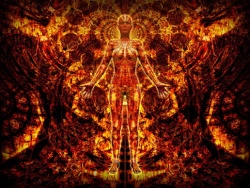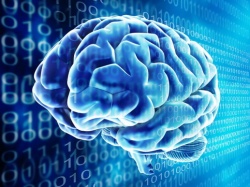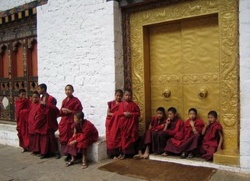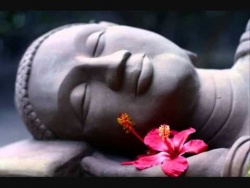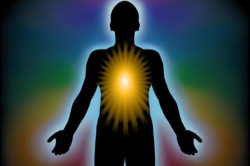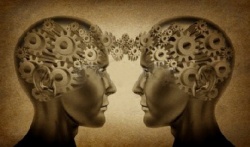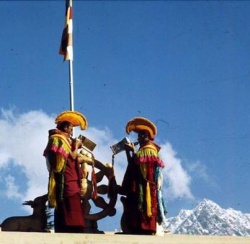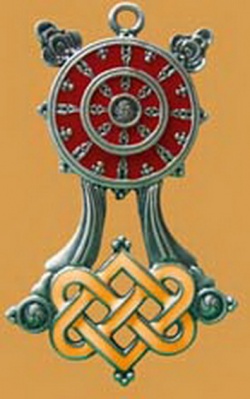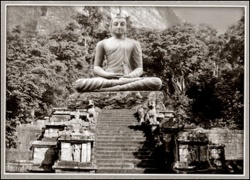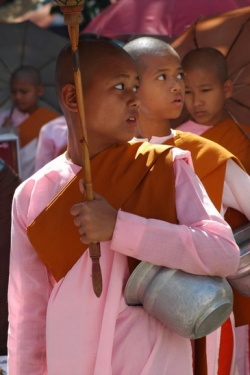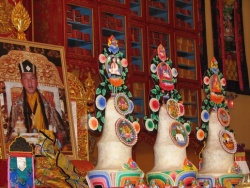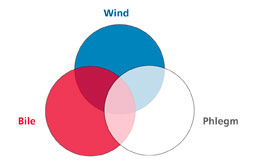Physiology of the humors and constituents
Nyepas, the three humors
Buddha Baishajaya Guru said in the beginning of the first tantra:
“Health sustainment or decline is defined by the
Normal or abnormal state of the
Humors, body constituents and waste products”.
As described in the mind chapter, the mind is the background, the pillar of life, the hidden power, the essence, and the covering of the body which provides the base for the physical body to exist. The humors then build the body constituents and develop the system of the body and its functions, and are the basis of the theory and practice of Tibetan Medicine. The theory describes the three principles of the humors and their threefold causes (mental predisposition, elemental energy and physical cause) and their functions.
The mental predispositions cause of the three humors
First of all, even before the physical actions, the mind plays its role. Marigpa (ignorance) is the source of everything including of the mind, itself. Ignorance produces the three mental predispositions and the delusions of the mind of the bardo consciousness, which unites with the parent’s two physical energies[1]. This is the start of life, as we are told in the first and second tantras. Consequently to the unification of the mind and matter, the mind becomes the cause of the manifestation of the three humors: attachment is the precondition for rLung[2]/Wind humor, hatred for mkhrispa/Bile, and closed-mindedness for Badken/Phlegm humor. These three energies arise respectively from the mental predispositions of the mind and become the psychic cause of the three humors.
The elemental energy cause of the three humors
Secondly, the energy cause for the three humors arises from the five elements energies: the wind element produces the Wind humor, the fire element manifests Bile, and the earth and water elements produce the Phlegm humor. The ether or space element is pervasive to all humors like the globe of Earth hanging in space and supported by all the five elements.
The physical cause of the three humors
Thirdly, the physical or material causes of the three humors are: the subtle wind element which carries the bardo consciousness during its journey, and becomes the cause of the Wind humor and the nervous system; the sperm, which is the cause of the Phlegm humor and of the lymphatic and endocrine systems; the menstrual blood (ovum), which is the cause of the Bile humor, the blood and blood circulation and of the metabolic systems.
The three humors, through their triple-fold dimension (psychic, energetic and physical) develop the body, and govern the body/mind and its functions. They rule physiology, anatomy and morphology, regulate the functioning of the body, its organs, the brain, nerves, bones, blood circulation, lymphatic systems, digestion etc. Balanced humors give positive health and harmony to the body/mind, and provide a good base for the development of the body/mind, the immune system and protection. On the contrary, the loss of balance among the humors causes energy disharmony and physical and mental disequilibrium which may appear at any time and become the cause of diseases.
The three humors (Nyespa-gsum)
The humors primary origin is Ignorance and the secondary causes are the parents’ energy and the elements. As we are taught in Buddhism, these causes do not possess an absolutely pure and perfect nature because they are ordinary material substances. Consequently, aging, disease and eventually death exist. That is why the humors are called Nyespa, which means the ‘faults‘ of ‘delusion and having an imperfect quality‘. The humors comprise the physical and psychic three-fold dynamic energy which sustains the body/mind, its health and systems. The humors are the basic principles of Tibetan medicine on which all characteristics of pathology, diet, behavior, medicine, therapy and treatment are based.
The general functions of the humors
The humors sustain health, keep the body systems in order, transform the nutrients into body constituents and power, and regulate the body and mind functions. They have three types of characteristics and natures which function together balancing each other’s powers as described below.
The Wind humor has six qualities or characters while the Bile and Phlegm humors each have seven qualities. The different qualities of the three humors may be oppositional or homogenous. Opposite qualities neutralize the effects of the opponent energy and keep the system in balance, while homogenous qualities, for example food or medicine having the same quality, increase the energy of the related humors and, in case of excess, may lead to the manifestation of disorder. The powers of the humors struggle to rule the house of the body/mind and an inappropriate diet and wrong behavior may promote the cause of disease. Balance and homogeneity among the humors sustain and give strength to the body. In short, the humors inter-reactions and collaboration regulate the physical development, transformation, metabolism, temperature, respiration, blood circulation and lymph systems, as well as the aging and dying processes. The mind and the emotions are also regulated by the three humors. Generally, the humors are also like a body; when the body is young and healthy, the humors are strong and balanced according to the person’s constitution, and when the body gets older the humors’ strength and qualities also degenerate and become the cause of sickness.
A poison tree produces poisonous insects
The product of a material naturally bears the same nature and potential as the ‘mother’ material. According to the second tantra, “like a poisonous tree produces poisonous insects”. This is an example which illustrates how an imperfect quality produces the humors. The parents’ energies possess the physical humoral energy which is the quality, on the material level, which provides the direct condition for the development of the humors. Although the parent’s physical energies are impure and have an imperfect quality (physical material) and their nature is ordinary, they provide the life and health of the humors.
To develop the body, all three humors must be present along with the consciousness and the elements, because a single humor cannot produce nor develop the body. A severe lack of vital elements could lead to an unhealthy body/mind. But even if they all must be present, the humors do not exist in exactly equal strength, and one or two humors are dominant and govern the body. This distribution of the strength of the humors defines the body’s constitution.
The general three locations of the humors
The Phlegm humor is based in the head (brain, gland and cerebral fluid), which is called the ‘ocean of Phlegm‘. It functions and controls its system from the head downwards like the flow of water, and cools down Bile, and nourishes the body.
The Bile humor is based in the middle part of the body (heart, liver, gall bladder and digestive fire) and it is called the ‘fire of the body‘. It rules digestion, nutrition, tissue transformation and temperature. According to the nature of fire, it moves upward and goes to the head. It keeps the water of Phlegm in balance.
The Wind humor holds is based in the lumbar-sacral area, the lower abdomen (principally in the colon) and in the reproductive organs. Wind rises up from its base in the lower abdomen and moves all the energy. It controls the mind and emotions, fans the flames of Bile, and circulates the Phlegm energy. It continuously makes the energy circulate up from the front side of the body, and to flow down from the head to the bottom of the body through the back and up again from the front. It also maintains balance among the humors and controls the humoral functions.
| Basic psychic causes | Mental condition and elements |
Physical conditions | Humors |
| Ignorance | Attachement |
Middle channel Secret chakra |
Wind humor |
| Ignorance | Hatred |
Right channel Heart chakra |
Bile humor |
| Ignorance | Closed-mindedness |
Left channel Crown chakra, Spleen/kidney |
Phlegm humor |
The natures of the three humors
The nature of the Wind humor is cold but neutral, while Bile is hot and sharp and Phlegm is cold and humid.
Wind is neutral and corresponds to eclipse or balance, while Bile corresponds to the sun and produces solar energy and Phlegm humor is like the moon and produces lunar energy.
The general Wind humor (rLung-spyi)
The Wind humor is the breath, life force, and energy of the body/mind. It is pervasive and circulates inside and outside of the body. It manifests from the mind and the subtle wind energy and it is the source of respiration, movement, strength, and the power of the body/mind. It especially governs the main function of the mind and the wind systems. During embryo development, it goes down to the perineum and moves upward to the head straight from the navel chakra through the central channel, piercing the five chakras like a tree and its root. It is called the ‘Wind humor’ and its most important branch is the life sustaining wind (srog’zingyi-rlung).
The Wind humor is concentrated in the central channel where the mental consciousness is active and the life fuel energy is deposited. This is the root and trunk of the Wind energy. The central channel has five chakras which are like the nodes of a tree while the organs and sensory organs are like the tree’s fruits and flowers.
The Wind humor has five principal winds and five minor winds which comprise the vital wind energy. They sustain life and manifest from the emotions of attachment and desire.
The Wind humor shares the same nature and characteristics as wind in general or air but the ‘human bodily wind’ is subtler and smoother. The Wind humor governs the central channel and its branches, and, along with the Bile and Phlegm humors, the central part of the body. It rules psychic functions and emotions and neutrally balances the other two humors.
There are three main sources for the Wind humor
1. The continuum subtle wind energy coming from the past life with the bardo consciousness is called the ‘mental affliction wind’ (nyonmongpai-yidkyi-rLung [3]) and it is the main cause of the Wind humor.
2. The wind energy received and developed from the wind element of the parents and especially from the mother during fetus development becomes the physical Wind humor.
3. The Wind energy is also received throughout life from the food and air which support the Wind humor system.
The Wind humor’s location and general functions
The Wind humor is found in every part of the body but it is particularly active in the heart, lungs, colon, small intestine, skin, ears, bones, hip joints, joints, lumbar-sacral area, lower abdomen and nervous system. Tibetan Medicine and Yoga tantra describe five main wind branches of the general Wind humor. They are also called the principal or root winds and they are mainly located in the five chakras of the five body parts, from where they govern the psychic and body functions. The five chakras are: the crown chakra, throat chakra, heart chakra, navel chakra and secret chakras. In short they are the cause, governor, and sustainer of the five emotions and psychic energies. Functionally, the Wind humor is a cold but neutral energy and it is equally able to associate itself with Phlegm or Bile. Wind serves as the vehicle of the mind and enables the mind to perceive sensations and thought. Wind regulates respiration and mobility, and sustains life through breathing; it gives energy for movement, and makes blood, lymph and subtle energy circulate. Wind helps absorb nutrition, transform tissues, clear the sensory organs, and sustain their functions. It controls the senses, as well as the functions of the vital and hollow organs. It transfers memory and experience of the gross mind to the subtle mind. In short: all the physical and mental functions depend on the Wind humor. Wind gives life to the body as well as to the body’s microorganisms. Wind transports the consciousness, lightens awareness and gives power to the mind.
The six characters of the Wind humor
The Wind humor has six qualities or characters: it is coarse (rough), light, cold, subtle, hard and mobile. These six qualities maintain the body in a general way by balancing the other two humors. Wind keeps Bile and Phlegm in balance and equilibrium by neutralizing the opposite elements. But when the Wind itself becomes too strong, it attacks the other two humors, takes power from them and creates an imbalance. Then the body begins to show the Wind symptoms of dryness (coarseness), physical and mental lightness and restlessness, as well as sensitivity to cold. The mind becomes more fragile and subtler (sensitive), while the wind’s quality of hardness manifests lump, abscesses, tumors and swellings, and the body/mind’s nature becomes unstable.
Wind has a neutral nature and it is able to associate itself with the other two humors: Wind helps increase the Bile fever but also cools down the Phlegm humor. However, Wind itself has a cold nature and dry nature.
The types of Wind humor (rLunggi-rigs)
Wind is found in all parts of the body and in all cells and particles. All winds in short belong to the five principal and five minor winds. They functions in the head, throat, chest, abdomen, lower abdominal and in the back of the body and in the coccyx area. The five principal winds govern and help manifest the five gross emotions of ignorance, attachment, anger, pride, and jealousy respectively from the five chakras: crown, throat, heart, navel and secret chakra. The five chakras or body divisions are like the five provinces of a state where the principal winds are the governor. The five minor winds rule the five sensory faculties and they derive from the principal winds. There are many other different types of winds which manifest from the principal winds, and each wind is responsible for a different emotion. Winds and emotions manifest through the function of the body channels of the five chakras. The Buddhist sutras describe 84.000 emotions while the Mother Tantra counts 72.000 emotions[4].
The five principal Wind branches (rTsawei-rlung-lna)
The five principal Winds function separately in five different body locations or chakras, under the general command of rLung/wind humor. They all manifest from the Life sustaining Wind (Srog’zingyi-rlung) of the central channel during the fetus development, like rays emerging from the sun.
They are:
| No | Wind | Chakras and body parts | Negative emotions |
| 1 | Life sustaining Wind (Srog-‘zin-rlung) |
Head and crown chakra | Ignorance |
| 2 | Ascending Wind (rGyen-rgyui-rlung) |
Upper body and throat chakra | Attachment |
| 3 | Pervasive Wind (Khyab-byed-rlung) |
Chest and heart chakra Anger | Anger |
| 4 | Fire-like Wind (Memnyam-rlung) |
Abdomen and navel chakra | Pride and greed |
| 5 | Descending Wind (Thursel-rlung) |
Lower abdomen and secret chakra | Fear and jealousy |
Five Wind Branches
1. Life sustaining Wind (srog ‘dzin rlung )
The Life sustaining Wind is a Wind which resides in the head (brain). It manifests from the central channel, from the subtle Wind of the mind and governs the head and the whole body/mind system. Also called Life-span Wind, it is the life fuel energy (tshe) stored in the middle channel and the bank of life energy like oxygen in a cylinder. It is released through the nostrils during respiration.
The breath is comprised of two components: the greater part of the breath which is the body wind (las rlung: karmic wind, meaning body breaths) and the Life sustaining Wind (srog ‘dzin rlung) more subtle and found in a smaller amount. Both come out from the central channel along with respiration. The breath, which contains a tiny amount of the Life sustaining Wind also divides into two parts when it reaches the nostril root. One part goes to the crown chakra (brain) and is burnt there, becoming the energy which supports the consciousnesses and the continuation of the Life sustaining Wind (brain) function. The second part of the breath comes out from the mouth and nostrils. This continuous use of the life energy resource reduces its amount day by day, like a candle slowly being consumed.
Generally, the quantity of life energy in the central channel is the basic life span of the person and its body/mind force. Each person has a different amount of the life fuel energy and, according to Buddhism, this amount is determined by the previous lives’ karma. Therefore, no one else but oneself is responsible for the lifespan amount [5]. It is difficult for common people to foresee the amount of this energy.
Functions
The Life sustaining Wind functions in the brain, sensory organs, mouth, nostrils, and esophagus. It regulates the nervous system, brain memory and it gives thinking and analytical powers and attention. It determines the emergence of the sense of “I” and controls the body system and the functions of the organs. It helps to swallow food, breathe, sneeze, spit, vomit, belch, etc. It clears the mind and the sensory organs and sustains life. In short, it governs the whole head (brain) and crown chakra (psychic), and commands the entire body system. It regulates the pillar of the body or central energy channel, and the respiration function. It keeps the body/mind balanced and holds and sustains the mind and the mental functions. Psychologically, it manifests ‘closed-mindedness’ and the lack of awareness (by incomplete function) which requires human beings to learn and train themselves in order to develop.
Malfunction of the Life sustaining Wind
If the Life sustaining Wind functions become distorted and disturbed by wrong factors, one may lose consciousness and balance, manifest vertigo, lose control of the body/mind, have wrong perceptions, confusion, hear sounds in the head and ears, experience feelings of head emptiness, and have hallucinations. It may cause shortness of breath; difficulty of inhalation, problems in swallowing food and drink, and could even become the cause of madness.
2. Ascending Wind (rgyen rgyu’I rlung)
The Ascending Wind (rgyen rgyu’I rlung) resides in the chest, lungs, throat, larynx, mouth and nasal cavity and especially in the vocal cords. It moves upwards to the throat and makes breathing through the lungs, trachea and nostrils possible. The body/mind energy flowing up to the head through the throat is an extremely important function for the balance of the body/mind.
Functions
It functions in the throat, larynx, tongue and nostril areas, it produces speech and voice, maintains the strength of the body, increases the body’s radiance, clears out the skin and complexion and generates interest and skills in art and works, and clears the memory and awareness. It eliminates excretions like sputum, mucus, etc from the mouth, nose and other sensory organs, throat, lungs, heart and chest. In short, it rules the throat and neck areas and produces the vocal sounds. Psychologically, the Ascending Wind manifests attachment, desire and lust. It also provokes anger and nervousness.
Malfunction of the Ascending Wind
This wind could be the cause of many disorders of the upper part of the body such as thyroid and lungs disorders, sore throat, loss of voice, breathing difficulties, headaches and neck and shoulder pain. It also increases the pressure in the sensory organs and head, produces problems of speech, loss of strength, facial paralysis and loss of consciousness. Disharmony of this wind during the fetus development could manifest in various spinal or spondylolisthesis disorders as well as back, neck and chest deformations. The mother’s psychological problems may influence this wind which could produce fetal malformation.
3. Pervasive Wind (khyab byed rlung)
The Pervasive Wind (khyab byed rlung) resides in the heart, chest and shoulders, arms and hands, but it also pervades the whole body.
Functions
It is responsible for body movements including lifting the arms up and down, stretching, and bending. It regulates the organs and cavity functions, keeping one’s body in balance and providing a straight posture, etc. It sustains the heart function, makes the blood and wind circulate in all parts of the body and distributes the nutrition and nourishes the body. In short it rules all physical actions of the whole body especially in the chest. Psychologically, this wind produces anger, hatred and the emotions of the mind arising from the heart. Therefore, according to Tibetan medicine Bile and anger reside in the chest.
Malfunction of the Pervasive Wind
The Pervasive Wind malfunction manifests in loss of balance, hypertension, chest tension, fear, panic attacks (Wind in the heart), fainting, loss of speech, general cardiac disorders, talkativeness, the desire to roam, pains in the joints, shoulders and back, blood circulation disorders, heart palpitations and rhythm disturbances, and in complaining and unfriendly speech which worsens the situation, etc.
4. The Fire-like Wind (me mnyam rlung)
The ‘Fire-like Wind‘ or ‘Fire accompanying Wind’ (me mnyam rlung) resides in the stomach and intestines. It is the bile fire fanned by wind and so is called me nyam, fire-like.
It is the firepower which helps the Digestive Bile to digest food. It performs its functions in the general and specific digestive systems. It assimilates and absorbs nutrition, matures the nutrients and transports the food essences (chyle) to the liver and body. In short, it governs the abdominal area below the diaphragm and above the navel.
Psychologically, this wind manifests a hunger for food, power, egotism, pride, and greed.
Malfunction of the Fire-like Wind
Malfunction of this wind causes cold stomach, poor appetite, vomiting, and disturbed blood circulation of the stomach [6]. It also manifests all the chronic and acute digestive disorders, especially in the lower abdominal organs, including gas formation, gastric problems, hiatal hernia, tension in the heart, back and chest pains, intestinal irritations, constipation, low metabolism, bacterial flora disorders, mal absorption, etc.
5. Descending Wind (thur sel rlung)
The Descending Wind (thur sel rlung) resides and functions in the colon, bladder, reproductive organs, thighs, and especially in the sigmoid colon. It governs the part of the body below the navel. As it functions downwards, it is called the ‘Descending Wind’.
It regulates the functions of the sexual activities, controls the evacuation of feces and urine, as well as semen and menstruation discharge. It rules conception, fetus development and labor, and so keeps the generations going on. Psychologically, this Wind helps manifest jealousy, fear and worries which are due to problems of lacking space in the heart.
Malfunction of the Descending Wind
Malfunction or disturbances of this Wind manifest in the joints with a boiling pain, loose or rigid and hard joints. It produces lower abdominal disorders such as lumbar and back pains, constipation, infertility, bladder, urination and ejaculation disorders, menstrual disorders, hemorrhoids, intestinal hernia, lower body blood circulation disorders.
Psychologically, this Wind manifests joy and pleasant emotions but it also becomes the basis for psychological imbalances and wind disorders.
Footnotes
- ↑ About the subtle wind with other elements, see more in the embryology chapter
- ↑ rlung should be pronounced like ‘lung‘, mkhrispa like ‘Tripa‘ and Badken like ‘Beken‘
- ↑ This wind manifests from attachment, and remains with the mind and produces all the mental affliction thoughts.
- ↑ More details can be found in the Abhidharma and Buddhist tantras.
- ↑ Detailed explanations can be found in tantra, Kalachakra tantra astrology and Svarodhaya “dbyang’ char” astrology tantras.
- ↑ This concept is described in the bloodletting chapter of the 4th tantra
